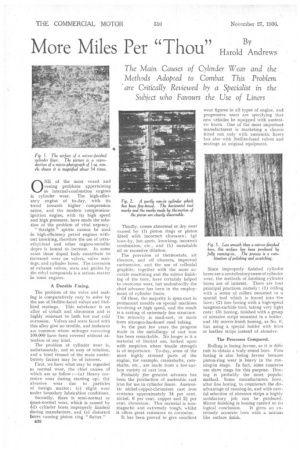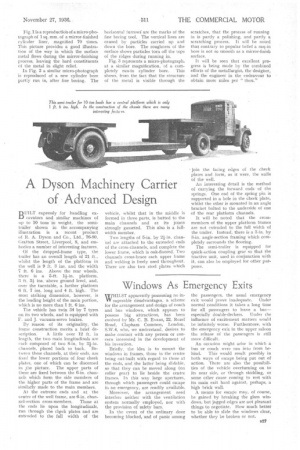More Miles Per "Thou" Harold B Andrew's O NE of the most vexed and
Page 36

Page 37

If you've noticed an error in this article please click here to report it so we can fix it.
vexing problems appertaining to internal-combustion engines is cylinder wear. The high-efficiency engine of to-day, with its trend towards higher compression ratios, and the modern compressionignition engine, with its high speed and high pressures, have made the solution of the problem of vital urgency.
" Straight" spirits cannot be used in high-efficiency petrol engines without knocking, therefore the use of tetraethyl-lead and other organo-metallic dopes is bound to increase. In some cases these doped fuels contribute to increased wear on valves, valve seatings, and cylinder bores. The corrosion of exhaust valves, seats and guides by the ethyl compounds is a serious matter in some engines.
A Durable Facing.
The problem of the valve and seating is comparatively easy to solve by the use of Stellite-faced valv.es and Stellited seatings. This substance is an alloy of cobalt and chromium and is highly resistant to both hot and cold corrosion. Valves and seats faced with this alloy give no trouble, and instances are common where mileages exceeding 100,000 have been covered without attention of any kind.
The problem of cylinder wear is, unfortunately, not so easy of solution, and a brief resume of the main contributory factors may be of interest.
First, we have what may be regarded as normal wear, the chief causes of which are as follow :—(a) Heavy corrosive wear during starting up ; (b) abrasive wear due to particles of foreign matter ; (c) slight wear under boundary lubrication conditions.
Secondly, there is semi-normal or quasi-normal wear, which is caused by (d) cylinder bores improperly finished during manufacture, and (e) distorted bores causing piston ring " flutter."
is26 Thirdly, comes abnormal or dry wear caused by (f) piston rings or piston fitted with incorrect clearance; (g) biow-by, hot spots, knocking, incorrect combustion; etc., and (h) unsuitable oil or excessive dilution.
The provision of thermostats, air cleaners, and oil cleaners, improved carburation, and the use of colloidal graphite, together with the more accurate machining and the mirror finishing of the bore, have certainly helped to overcome wear, but undoubtedly the chief advance has been in the employment of cylinder liners.
Of these, the majority is spun-cast in permanent moulds on special machines revolving at high speed, and the result is a casting of extremely fine structure. The minority is sand-cast, or made from nitrogen-hardened steel tubing.
in the past few years the progress made in the metallurgy of cast iron has been remarkable. No longer is it a material of limited use, looked upon with suspicion where tensile strength is of importance. To-day, some Cif the most highly stressed parts of the engine, for example, crankshafts, camshafts, etc., are made from a low-carbon variety of cast iron.
Probably he greatest advance has been the production of austenitic cast iron for use in cylinder liners. Austenitic nickel-copper-chromium cast iron contains approximately. 14 . per cent. nickel, 6 per cent, copper and 2. per cent. chromium.This material is nonmagnetic and extremely tough, whilst it offers great resistance to corrosion.
It has been proved to give excellent wear figures in all types of engine, and progressive users are specifying that new vehicles be equipped with austenitic liners. One of the most important manufacturers is marketing a chassis fitted not only with austenitic liners but also with Stellite-faced valves and seatings as original equipment.
Since improperly finished cylinder bores are a contributory cause of cylinder wear, the methods of finishing cylinder bores are of interest. There are four principal practices, namely: (1) rolling with a series of rollers mounted in a special tool which is forced into 'the fore; (2) fine boring with a high-speed tungsten-carbide tool, taking very light cuts ; (3) honing, finished with a group of abrasive strips mounted in a holder, and (4) mirror-finish honing, as No. but using a special holder with fibre or leather strips instead of abrasive.
The Processes Compared.
Rolling is losing favour, as it is difficult to obtain a truly round bore. Fins boring is also losing favour because piston-ring wear is heavy in the running-in stage. In fact, some concerns use slave rings for this purpose. Honing is probably the most popular method. Some manufacturers hone, after fine boring, to counteract the disadvantage of running-in, and with careful selection of abrasive strips a highly satisfactory job can be produced. Mirror finishing is honing carried to its logical conclusion. It gives an .extremely accurate bore with a mirrorlike surface finish.
Fig. 1 is a repmductioii of a micro-photograph of 1 sq. mm, of a mirror-finished cylinder liner, magnified 70 times, This picture provides a good illustration of the way in which the surface metal flows during the mirror-finishing process, leaving the hard constituents of the metal in slight relief.
In Fig. 2 a similar micro-photograph is reproduced of a new cylinder bore partly run in, after tine boring. The horizontal furrows : are the marks of the fine boring tool. The vertical lines are caused by particles carried up and down the bore. The roughness of the surface shows particles torn off the tops of the ridges during running in.
Fig. 3 represents a micro-photograph, at a similar magnification, of a completely run-in cylinder bore. This shows, from the fact that the structure of the metal is visible through the scratches, that the process of runningin is partly a polishing, and partly a scratching process, It will be noted that contrary to popular belief a ruq-in bore is not so smooth as a mirror-finish surface.
it will be seen that excellent progress is being made by the combined efforts of the metallurgist, the desigher, and the engineer in the endeavour to obtain more miles per " thou."




















































































